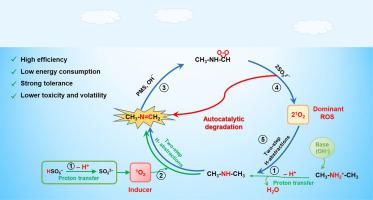Water Research ( IF 12.8 ) Pub Date : 2023-05-23 , DOI: 10.1016/j.watres.2023.120119 Lidong Wang 1 , Yanan Wang 1 , Zhixiang Wang 2 , Penghui Du 3 , Lei Xing 4 , Weichao Xu 2 , Jincheng Ni 1 , Shuai Liu 1 , Yihao Wang 1 , Guangfei Yu 1 , Qin Dai 1

|
Removal of low-carbon fatty amines (LCFAs) in wastewater treatment poses a significant technical challenge due to their small molecular size, high polarity, high bond dissociation energy, electron deficiency, and poor biodegradability. Moreover, their low Brønsted acidity deteriorates this issue. To address this problem, we have developed a novel base-induced autocatalytic technique for the highly efficient removal of a model pollutant, dimethylamine (DMA), in a homogeneous peroxymonosulfate (PMS) system. A high reaction rate constant of 0.32 min−1 and almost complete removal of DMA within 12 min are achieved. Multi-scaled characterizations and theoretical calculations reveal that the in situ constructed C=N bond as the crucial active site activates PMS to produce abundant 1O2. Subsequently, 1O2 oxidizes DMA through multiple H-abstractions, accompanied by the generation of another C=N structure, thus achieving the autocatalytic cycle of pollutant. During this process, base-induced proton transfers of pollutant and oxidant are essential prerequisites for C=N fabrication. A relevant mechanism of autocatalytic degradation is unraveled and further supported by DFT calculations at the molecular level. Various assessments indicate that this self-catalytic technique exhibits a reduced toxicity and volatility process, and a low treatment cost (0.47 $/m3). This technology has strong environmental tolerance, especially for the high concentrations of chlorine ion (1775 ppm) and humic acid (50 ppm). Moreover, it not only exhibits excellent degradation performance for different amine organics but also for the coexisting common pollutants including ofloxacin, phenol, and sulforaphane. These results fully demonstrate the superiority of the proposed strategy for practical application in wastewater treatment. Overall, this autocatalysis technology based on the in-situ construction of metal-free active site by regulating proton transfer will provide a brand-new strategy for environmental remediation.
中文翻译:

质子转移触发 C=N 活性位点的原位构建以激活 PMS 以高效自催化降解低碳脂肪胺
由于低碳脂肪胺 (LCFA) 分子小、极性强、键解离能高、电子缺乏和生物降解性差,因此在废水处理中去除低碳脂肪胺 (LCFA) 是一项重大的技术挑战。此外,它们的低 Brønsted 酸度加剧了这个问题。为了解决这个问题,我们开发了一种新型碱诱导自催化技术,用于在均相过一硫酸盐 (PMS) 系统中高效去除模型污染物二甲胺 (DMA)。实现了0.32 min -1的高反应速率常数和在 12 分钟内几乎完全去除 DMA。多尺度表征和理论计算表明,原位构建的 C=N 键作为关键活性位点激活 PMS 产生大量1欧2。随后,1 O 2通过多次H-抽取氧化DMA,同时生成另一个C=N结构,从而实现污染物的自催化循环。在此过程中,污染物和氧化剂的碱诱导质子转移是 C=N 制造的必要先决条件。分子水平的 DFT 计算揭示并进一步支持了自催化降解的相关机制。各种评估表明,这种自催化技术表现出较低的毒性和挥发性过程,以及较低的处理成本(0.47 $/m 3). 该技术具有很强的环境耐受性,尤其是对高浓度的氯离子(1775 ppm)和腐植酸(50 ppm)。此外,它不仅对不同的胺类有机物表现出优异的降解性能,而且对氧氟沙星、苯酚和萝卜硫素等共存的常见污染物也表现出优异的降解性能。这些结果充分证明了所提出的策略在废水处理实际应用中的优越性。总的来说,这种基于通过调节质子转移原位构建无金属活性位点的自催化技术将为环境修复提供一种全新的策略。


























 京公网安备 11010802027423号
京公网安备 11010802027423号